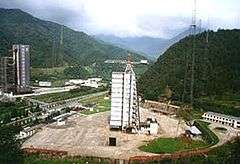Xichang Satellite Launch Center
The Xichang Satellite Launch Center (XSLC), also known as the Xichang Space Center, is a People's Republic of China space vehicle launch facility (spaceport) in Zeyuan Town, approximately 64 kilometres (40 mi) northwest of Xichang, Liangshan Yi Autonomous Prefecture in Sichuan.
| Xichang Satellite Launch Center | |
|---|---|
西昌卫星发射中心 | |
 Xichang Satellite Launch Center | |
 Location within Sichuan  Xichang Satellite Launch Center (China) | |
| Alternative names | Base 27 |
| General information | |
| Location | Xichang, Liangshan, Sichuan |
| Coordinates | 28°14′45.66″N 102°1′35.60″E |
| Opened | 1984 |
| Xichang Satellite Launch Center | |||||||
|---|---|---|---|---|---|---|---|
 | |||||||
| Simplified Chinese | 西昌卫星发射中心 | ||||||
| Traditional Chinese | 西昌衛星發射中心 | ||||||
| |||||||
The facility became operational in 1984 and is used to launch numerous civil, scientific, and military payloads annually.[1][2] It is notable as the site of Sino-European space cooperation, with the launch of the first of two Double Star scientific satellites in December 2003. Chinese officials have indicated interest in conducting additional international satellite launches from XSLC.[3]
In 1996, a fatal accident occurred when the rocket carrying the Intelsat 708 satellite failed on launch from the Xichang Satellite Launch Center. Also, a 2007 test of an anti-satellite missile was launched from the center.
History
China's first manned space program
In order to support the Chinese Project 714 manned space program in the 1960s, the construction of a new space center at Xichang in the Sichuan province was decided, located farther from the Soviet border, thus safer. The Shuguang One spacecraft was expected to be launched from the launch pad number one. After the cancellation of the program, the launch pad was never completed. Today, a viewing platform for officials has been built at the site.[4]
First Long March-2E carrier rocket
China launched its first Long March-2E carrier rocket on 16 July 1990, sending into orbit Pakistan's first indigenously developed Badr-1 satellite and HS-601.
1996 Launch accident
On 15 February 1996, a fatal accident occurred when the first new Long March 3B heavy carrier rocket carrying Intelsat 708 veered off course 22 seconds after launch, crashing 1200 meters away from the launch pad in a nearby mountain village, destroying 80 homes. According to the official report, six people died and 56 were injured.[5] The number of civilian deaths has been disputed, with estimates of the number of casualties ranging in the few hundred ballpark.[6][7] See the Intelsat 708-article.
China's first successful ASAT test
China conducted on 11 January 2007 an anti-satellite missile test with a SC-19 ASAT weapon.
A Chinese weather satellite — the FY-1C polar orbit satellite of the Fengyun series, at an altitude of 865 km, with a mass of 750 kg — was destroyed by a kinetic kill vehicle.
The SC-19 has been described as being based on a modified DF-21 ballistic missile or its commercial derivative, the KT-2 with a Kinetic Kill Vehicle and is fully mobile.
Beginning of China's lunar exploration program
On October 24, 2007, Chang'e 1, an un-manned Moon orbiter of the Chang'e program, was successfully launched from the facility, marking the beginning of China's lunar exploration program.[8]
First Long March-3C carrier rocket
China launched its first Long March-3C carrier rocket on April 25, 2008. This was the 105th mission of China's Long March series of rockets, and also the launch of the nation's first data relay satellite (数据中继卫星) Tianlian I (天链一号).[9]
A new launch pad for next-generation rockets (such as Long March 8) is currently under construction, as of December 2019.[10]
Facilities
Launch Complex 1 (LC-1)
Not built Shuguang launch site, later used as a viewing area.[11]
Launch Complex 2 (LC-2 or LA-2)
Used for launching Long March 2E, Long March 3A, Long March 3B[12][13] and Long March 3C rockets.
Launch Complex 3 (LC-3 or LA-3)
Also known as LA-1. Used for launching Long March 2C, Long March 3, Long March 3A and Long March 3B rockets. Demolished and rebuilt between 2005 and 2006. Upgraded in order to support the Chinese Lunar Exploration Program.[14] Demolished and rebuilt again between 2013 and 2015.
Technical Center
XSLC's Technical Center is equipped for testing and integration of the payload and launch vehicle. Its Mission Command and Control Center is located 7 kilometres (4.3 mi) southwest of the launch pads, and provides flight and safety control during overall system rehearsal and launch. It is serviced by a dedicated railway and highway directly from Xichang Qingshan Airport and Manshuiwan railway station, which is about 50 kilometres (31 mi) away from the launch site. Two launch complexes at the facility support flight operations.[15]
See also
- Chinese space program
- Jiuquan Satellite Launch Center
- Taiyuan Satellite Launch Center
- Wenchang Satellite Launch Center
References
- March 2020, Hanneke Weitering 24. "China's Long March 2C rocket launches military surveillance satellites into orbit". Space.com. Retrieved March 30, 2020.
- March 2020, Elizabeth Howell 12. "China's new navigation system is nearly complete with penultimate Beidou satellite launch". Space.com. Retrieved March 30, 2020.
- "Dongfanghong IV ready for more int'l satellite orders". Xinhua News Agency. Archived from the original on October 2, 2008.
- "百人大厅静得能听见掉下一根针". Shanghai Morning Post. October 22, 2007. Retrieved November 20, 2007.
- "96年火箭发射失控爆炸全过程". 大旗网. September 15, 2007. Retrieved June 13, 2008.
- Anatoly Zak (February 2013). "Disaster at Xichang". Air & Space Magazine. Retrieved April 21, 2013. (Article on the crash of a rocket carrying a commercial payload on February 15, 1996)
- http://www.thespacereview.com/article/2323/1
- "China's 1st moon orbiter enters Earth orbit". Xinhua News Agency. October 24, 2007. Retrieved October 24, 2007.
- "我国首颗中继卫星发射成功 将测控神七飞行". 人民网. April 26, 2008. Retrieved April 27, 2008.
- Jones, Andrew (December 20, 2019). "China creates commercial space alliance, expands launch complex". SpaceNews. Retrieved December 20, 2019.
- "Xichang Satellite Launch Centre". SinoDefence.com. Archived from the original on January 3, 2010. Retrieved March 7, 2010.
- "China launches French-built satellite". Xinhua News Agency. June 9, 2008.
- "Long March 3B rocket launches Chinasat-9 satellite". Mister-Info.com.
- "西昌卫星发射中心重建发射塔为登月作准备". 人民网. September 19, 2006. Retrieved June 11, 2008.
- Profile of Xichang Satellite Launch Center, GlobalSecurity.org.
External links
- Aerial Maps from Google Maps